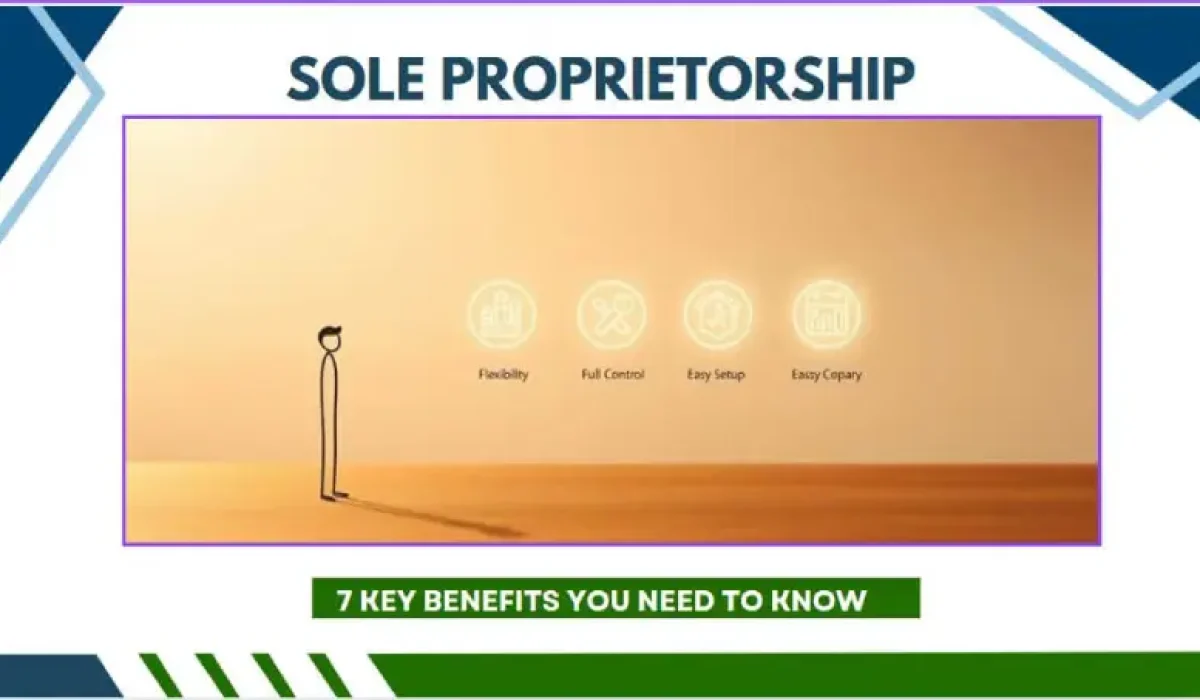Starting a business is a big step. Choosing the right structure is key. A Proprietorship is simple. It lets you report your business income and expenses on your taxes. Being your boss is great. You get to make choices and take risks. But, you need to know what owning a business means. You don’t have to file separate business taxes with a sole proprietorship. This makes it easy for solo entrepreneurs.
Table of Contents
Are you thinking about starting a business? It is important to know the pros and cons. In this article, we will see the benefits of single ownership and help you create a smart option.
Key Takeaways
- Simplified business structure for solo entrepreneurs
- No separate business taxes or complex financial records required
- Freedom to make decisions and take calculated risks
- Personal tax return reporting for business income and expenses
- Attractive choice for self-employed individuals
What Exactly Is a “Sole Proprietorship”?
A Sole Proprietorship is the simplest business type. It is owned and operated by a person. It is easy to start because of its simplicity.
Definition and Legal Status
A Sole Proprietorship is not a formal business. It’s not separate from its owner. This makes things easier for the owner. The owner must pay for all business debts. The business income goes on the owner’s tax return. This makes taxes easy to handle. This easy setup is a big plus. But, the owner’s stuff can be lost if the business owes money.
How It Compares to LLCs, Corporations, and Partnerships
A Sole Proprietorship doesn’t protect the owner’s stuff. LLCs and corporations do. Partnerships have more than one owner. When looking at these options, think about protection, taxes, and how hard they are to set up. A Sole Proprietorship is simple. But other types might be better for bigger businesses or those with more owners.
Who Should Consider a Sole Proprietorship?
Starting a business makes you think about the best structure. A Sole Proprietorship is great for many because it’s easy and flexible.
Ideal Candidates for This Business Structure
A sole proprietorship is perfect for the needs of small business structures. It’s great for freelancers who want to start fast and with little paperwork. It’s best for:
- Freelancers include writers, graphic designers, or consultants.
- Single-owner businesses with simple operations.
- Entrepreneurs who want to test an idea before growing.
Real-World Success Stories
Many successful businesses started as a Sole Proprietorship. Freelance writers and designers often start here. They like the simplicity and control. As they grow, some change into other structures. But many stay as Sole Proprietorships. They like the ease of management and focus on their work, like freelancing.
Benefits You Need to Know
1: Simplicity and Low Startup Costs
A Sole Proprietorship is easy and cheap to start. It’s perfect for quick business starts. You don’t need to deal with hard legal and money stuff.
Step-by-Step Registration Process
Starting a Sole Proprietorship is simple. First, pick a unique business name. Make sure it meets your state’s rules.
Choosing a Business Name
Choosing a name is key. It goes on all important papers and ads. Check if it’s free by looking in your state’s database.
Filing for Necessary Permits and Licenses
You might need special permits or licenses. Ask your local government what you need.
Setting Up Business Banking
Get a business bank account. It keeps your money separate. It also helps with business money management.
A Sole Proprietorship is very affordable. Here’s how it compares to other types:
Business Entity Startup Costs Ongoing Fees Sole Proprietorship $0 – $100 $0 LLC $500 – $1,000 $50 – $500 annually Corporation $1,000 – $5,000 $500 – $1,000 annually
2: Complete Control and Decision-Making Authority
Being a sole proprietor means you have unbridled decision-making authority. You can make big business decisions all by yourself. You don’t need anyone else’s okay.
The Power of Being Your Own Boss
Being your boss is a big plus of individual ownership. You can choose your business’s path. You decide on operations, money, and strategy without anyone else’s say. This freedom is great for those who like being independent. And who are sure they can handle business ownership on their own.
Effective Decision-Making Strategies for Solo Business Owners
To get the most from being self-employed, you need good decision-making plans.
Setting Clear Business Objectives
Having clear goals helps you make better choices. Your decisions will match your business aims.
Creating Decision-Making Frameworks
Building a decision-making plan helps you make choices faster. You can make smart decisions quickly.
When to Seek Outside Advice
Even with full control, sometimes getting outside help is smart. Experts can offer new ideas and help avoid risks.
Here’s how having full control affects business decisions:
Aspect Sole Proprietorship Other Business Structures Decision-Making Speed Fast, as decisions are made by one person Often slower, due to the need for consensus or approval from multiple stakeholders Control Over Business Direction Complete control, allowing for quick pivots or changes May be limited by the need to satisfy multiple owners or stakeholders Autonomy High, as the sole proprietor makes all decisions Varies, depending on the structure and the stakeholders involved
3: Favorable Tax Treatment
As a sole proprietorship, there are great tax allowances. This can save you a lot of money and make the treasure easier.
Understanding Pass-Through Taxation
As the only owner, your business revenue is seen as your personal income. This means that you only pay taxes once, not twice. The IRS says you are not like a separate business. This simplifies taxes and can be reduced to being outstanding.
Navigating Self-Employment Taxes
But, as a sole proprietor, you also have to pay self-employment taxes. You pay both the employer and employee parts of payroll taxes. But, you can deduct half of this as a business expense. Tax experts say this tax helps fund Social Security and Medicare, like employee wages.
Maximizing Business Deductions
To pay less in taxes, take all the deductions you can. This includes:
- Home Office Deductions: You can deduct part of your rent or mortgage and utilities for your office.
Home Office Deductions
- Getting a tax break for your home office is big. The IRS lets you use a simple rate per square foot.
- Business Travel and Vehicle Expenses: You can deduct costs for business trips and using your car for work.
Business Travel and Vehicle Expenses
- Keep good records of your business travel and car use. This includes fuel, maintenance, and where you stay.
- Healthcare and Retirement Options: Use health savings accounts and retirement plans like SEP-IRAs.
Healthcare and Retirement Options
- Sole proprietors can use health savings accounts and retirement plans. This lowers your taxable income and helps your future.
Knowing and using these tax benefits can really help. As “The Tax Adviser” says, “keeping good records and planning your taxes early are key to saving money.”
4: Minimal Regulatory Requirements
Sole proprietorships have fewer rules than other business types. This makes it easier for many entrepreneurs.
Less Paperwork and Reporting
There is less paperwork and fewer reports to do as a sole proprietor. This allows you to spend more time with your business. You won’t get bogged down with a lot of rules.
For example, unlike corporations and LLCs, you don’t have to file annual reports. This reduces the administrative burden and saves both time and money.
Privacy Advantages for Small Business Owners
Sole proprietorships also keep your business private. Since it’s not a separate legal entity, you don’t have to keep public records.
What Records You Must Keep
Even with fewer rules, keeping good financial records is key. You’ll need income statements, expense records, and tax returns. These help during tax time and audits.
Creating Simple Compliance Systems
To follow tax laws and other rules, sole proprietors can use simple systems. This might include accounting software or regular financial reviews.
Here’s a comparison of regulatory requirements for different business structures:
Business Structure Annual Reporting Requirements Public Disclosure Sole Proprietorship No annual reports required No public disclosure required LLC Annual reports required in some states Annual reports are required in some states Corporation Annual reports required Significant public disclosure required
5: Operational Flexibility and Adaptability
Sole proprietorship gives you the freedom to change quickly. This is key for any business to grow and succeed. Being able to adjust your plans fast can make all the difference.
Quickly Pivoting Your Business Model
Being able to change your business plan fast is a big plus. Unlike big companies, you can make decisions quickly. This lets you respond fast to new opportunities or challenges.
Creating Your Ideal Work-Life Balance
Flexibility also means you can work when you want. As a sole owner, you control your schedule. This can make you happier and healthier at work.
Setting Flexible Working Hours
Flexible hours help you balance work and life. You can work at times that fit your life. This lets you focus on personal things without stress.
Adapting to Market Changes
“The ability to adapt quickly to market changes is a hallmark of successful businesses, and sole proprietorship provides this flexibility.”
John Doe, Business Owner
This ability to change is very important today. It helps you stay ahead in a fast-changing world.
Scaling Up or Down with Ease
Flexibility also means you can grow or shrink your business easily. You can adjust to market needs without big problems. This is hard for big companies to do.
Benefit Description Flexibility The ability to quickly adjust business operations or models Work-Life Balance Autonomy to set one’s work schedule and environment Adaptability The capacity to change or pivot in response to market shifts Scalability The ease with which the business can scale up or down
6: Direct Profit Access and Financial Control
Being a sole proprietor means you get to keep all the profits. You also get to make all the money decisions fast. This lets you quickly adapt to changes or new opportunities in the market.
Managing Cash Flow as a Sole Proprietor
Keeping an eye on cash flow is key for any business. As a sole proprietor, you can watch your business’s money closely. You can fix any money problems right away.
- Check your cash flow often to spot trends and problems.
- Use a system to track your money in and out.
- Save some cash for unexpected costs.
Strategic Reinvestment for Business Growth
Putting profits back into your business is smart for growth. As a sole proprietorship, you choose how and when to use your money.
Creating a Profit Distribution Plan
Make a plan for how you’ll use your profits. You can reinvest, save, or take some home.
Separating Personal and Business Finances
Even though you don’t have to, keeping your personal and business money separate is smart. It makes managing money and taxes easier.
Building Business Credit
Having good business credit is good for getting loans later. As a self-employed person, start building credit by paying on time for business loans or cards.
7: Simple Business Dissolution Process
Many small business owners are lost with the thought of closing their business. For sole proprietors, though, it’s much simpler. This is because a sole proprietorship is the simplest type of business, so it does not have the complex components of a corporation or a partnership. If you own a sole proprietorship, there are some steps you need to take to close your business. You just need to understand what legal and financial steps you should take. This involves telling others and paying off any debts. The first step in the guide to closing your business would be telling customers and vendors about the closure.
Step-by-Step Guide to Closing Your Business
Telling customers and vendors first is very important. You should do this in a way that keeps their trust. Good communication helps avoid problems and makes the transition easier. You should tell them why you’re closing and when it will happen.
Notifying Customers and Vendors
It’s important to tell customers and vendors early. This lets them plan for the change. Telling them is not just nice; it’s necessary.
Settling Outstanding Obligations
After telling everyone, you need to pay off any debts. This means paying off what you owe, finishing tax returns, and taking care of other money matters. It’s important to do this right to avoid legal trouble and keep your finances clean.
Filing Final Tax Returns
Finally, you need to file your last tax returns. This means reporting all income up to when you close and claiming any deductions. Doing this right is important for following tax laws and for your own taxes.
Transitioning to a Different Business Structure
For some, closing their business is just a step to a new one. They might want to change because of the market or their goals. Knowing how to move to a new structure is important for success.
Steps Actions Importance 1. Notification Notify customers and vendors High 2. Financial Settlement Settle outstanding obligations High 3. Tax Compliance File final tax returns High 4. Transition Planning Plan for a different structure Medium
Potential Challenges and How to Overcome Them
Being a sole proprietor has many benefits. But you should know about the possible problems. Knowing these challenges helps you overcome them and keep your business growing.
Managing Personal Liability Risks
One big challenge is personal liability. As a sole proprietor, your personal stuff and business stuff mix together. This means you could lose your personal stuff if your business owes money. To protect yourself, you need to find ways to keep your personal stuff safe.
Obtaining Proper Insurance Coverage
Getting the right insurance is key to handling personal liability. Insurance can help if something bad happens or if someone sues your business. Talk to an insurance expert to find the best coverage for your business.
Creating Legal Safeguards
Legal protections are also important. This means making clear contracts and agreements. A lawyer can help ensure your business is well-protected.
Securing Business Funding
Finding money for your business can be hard. Sole proprietors might not get money from big banks. But, there are other ways to get the money you need.
Alternative Financing Options
Look into crowdfunding, personal loans, or lines of credit. These can give you the money to grow your business. Make sure you understand the terms of these options before you choose.
Building Strong Banking Relationships
Having a good relationship with your bank is also important. A good credit score and smart money management can help you get loans. This can help your business grow.
Planning for Business Growth and Succession
A plan is important for the future. You have to think about how to develop your business and what to do if you want to stop driving it. This may mean that it is passed or closed to someone else.
Conclusion: Is a “Sole Proprietorship” Right for You?
A sole proprietorship is great for many entrepreneurs. It’s simple, you have control, and it’s good for taxes. This business type is perfect for solo owners because it’s easy to manage. But, think about the downsides too. You might face personal liability risks, and finding money for your business can be hard. Knowing these things helps you decide if it’s right for you. In the end, a sole proprietorship is good for those who like simplicity and control. If you want to own your business alone and have flexibility, this might be for you.




